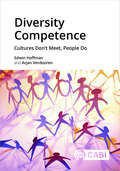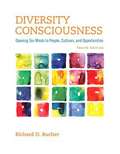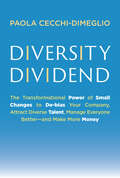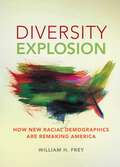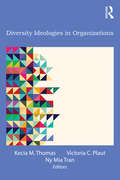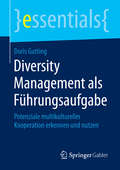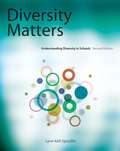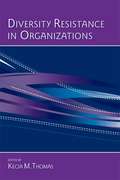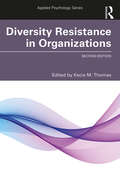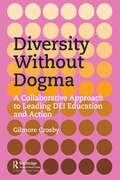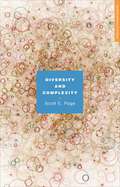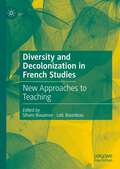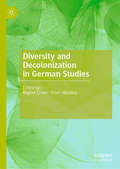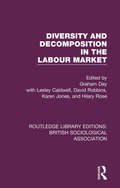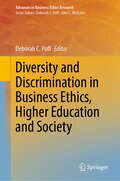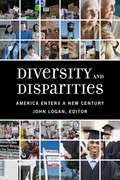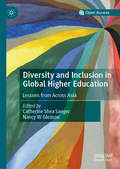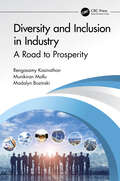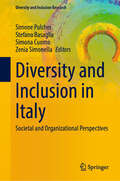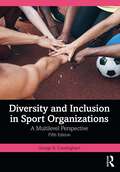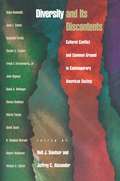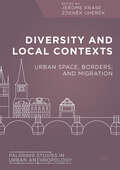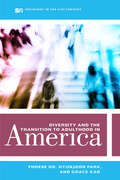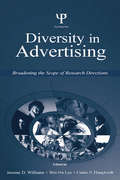- Table View
- List View
Diversity Competence: Cultures Don’t Meet, People Do
by Dr Edwin Hoffman Arjan VerdoorenIn today's world many people live, learn and work in international and multicultural environments. Intercultural communication has become an important topic in many fields of work and study. Given the complexities of globalization, knowledge of cultures and cultural differences is rarely sufficient. In this book, interpersonal communication forms the point of departure: the meeting of people, not of cultures. The authors describe what diversity competence entails: which processes, challenges and skills are relevant in a 'superdiverse' world. They demonstrate how the TOPOI model offers an inclusive, communicative approach to analyzing and addressing potential miscommunication. - Addresses controversial topics frankly and clearly without being simplistic. - Discusses theory from several different fields. - Case studies provide practical examples and guidelines. - Companion website with extra case studies and study assignments. The target audience for Diversity Competence includes students, educators and professionals in the fields of communication and media, business, management and leadership, governance and international relations and cooperation.
Diversity Consciousness: Opening Our Minds To People, Cultures, And Opportunities
by Richard D. BucherFor courses in Success/Orientation, Diversity (ie. Managing Diversity), Race and Ethnic Relations, Cultural Diversity in the Workplace, Multiculturalism and Inclusion (ie. leadership, group dynamics, teaching, social media/networking), Education, Nursing, Human Relations, Communications, Hospitality, Social Work/Family Therapy/Human Services, EMS and Fire Science, Counseling, Criminal Justice, Social Justice/Equity; also for teacher-training education courses, and staff/professional development workshops. This work on human diversity integrates personal and organizational perspectives, research, and theories while discussing teamwork, communication, leadership, conflict, social networking, and other issues in the workplace, at school, and in the community. Diversity Consciousness empowers students by helping them develop a "mind-set" which will enable them to be more successful in the 21st century.
Diversity Dividend: The Transformational Power of Small Changes to Debias Your Company, Attract Dive rse Talent, Manage Everyone Better and Make More Money
by Paola Cecchi-DimeglioFrom entry-level to the boardroom, what works to create large-scale change in organizations looking to accelerate their diversity, equity, and inclusion efforts and reap financial benefits.Every leader endeavors to invest in and manage their key asset—talent—to be as high-performing as possible. Like a winning stock, successful diversity, equity, and inclusion (DEI) actions pay back over time. That dividend is paid both to the company—through not only higher performance but also talent acquisition, training, and other savings—and to society in general. In Diversity Dividend, Paola Cecchi-Dimeglio offers a fresh, detailed look at how to realize gender and racial equity along the company-employee pathway—from attracting and interviewing applicants to onboarding, promoting, and sustaining hires—and how to remove systemic barriers at the organizational level that prevent women and underrepresented groups from advancing. While other books have delved into DEI and the challenges inherent in sustaining successful efforts, no book has done so in concert with the depth and scope of data, basis in science, and application in the real world. In Diversity Dividend, Cecchi-Dimeglio artfully combines accessible anecdotal cases—where success was achieved or where, despite best intentions and efforts, things did not go as expected—with scientifically rigorous solutions as well as applications of data and big data.As empowering as it is comprehensive, Diversity Dividend helps remove the guesswork and near-superstition that naturally arise when some methods work and others fail, thereby giving leaders the tools and insight to make informed choices at the right moments to create lasting change.
Diversity Explosion
by William H. FreyAt its optimistic best, America has embraced its identity as the world's melting pot. Today it is on the cusp of becoming a country with no racial majority, and new minorities are poised to exert a profound impact on U.S. society, economy, and politics. In April 2011 a New York Times headline announced, "Numbers of Children of Whites Falling Fast." As it turns out, that year became the first time in American history that more minority babies than white babies were born. The concept of a "minority white" may instill fear among some Americans, but William H. Frey, the man behind the demographic research, points out that demography is destiny, and the fear of a more racially diverse nation will almost certainly dissipate over time.Through a compelling narrative and eye-catching charts and maps, eminent demographer Frey interprets and expounds on the dramatic growth of minority populations in the United States. He finds that without these expanding groups, America could face a bleak future: this new generation of young minorities, who are having children at a faster rate than whites, is infusing our aging labor force with vitality and innovation.In contrast with the labor force-age population of Japan, Germany, Italy, and the United Kingdom, the U.S. labor force-age population is set to grow 5 percent by 2030. Diversity Explosion shares the good news about diversity in the coming decades, and the more globalized, multiracial country that U.S. is becoming.Contents1. A Pivotal Period for Race in America2. Old versus Young: Cultural Generation Gaps3. America's New Racial Map4. Hispanics Fan Out: Who Goes Where?5. Asians in America: The Newest Minority Surge6. The Great Migration of Blacks--In Reverse7. White Population Shifts--A Zero-Sum Game8. Melting Pot Cities and Suburbs9. Neighborhood Segregation: Toward a New Racial Paradigm10. Multiracial Marriages and Multiracial America11. Race and Politics: Expanding the Battleground12. America on the Cuspics Fan Out: Who Goes Where? 5. Asians in America: Where They Matter Most 6. The Great Migration in Reverse 7. Zero-Sum Game: White Gains and Losses 8. Melting Pot Cities and Suburbs 9. Neighborhood Segregation-Delayed Declines 10. Mixed-Race Marriages and Multicultural America 11. Race and Politics: Red, Blue, and Purple States 12. New Racial Demographics and the Nation's Future
Diversity Explosion
by William H. FreyAt its optimistic best, America has embraced its identity as the world's melting pot. Today it is on the cusp of becoming a country with no racial majority, and new minorities are poised to exert a profound impact on U.S. society, economy, and politics. The concept of a "minority white" may instill fear among some Americans, but William H. Frey, the man behind the demographic research, points out that demography is destiny, and the fear of a more racially diverse nation will almost certainly dissipate over time.Through a compelling narrative and eye-catching charts and maps, eminent demographer Frey interprets and expounds on the dramatic growth of minority populations in the United States. He finds that without these expanding groups, America could face a bleak future: this new generation of young minorities, who are having children at a faster rate than whites, is infusing our aging labor force with vitality and innovation. In contrast with the labor force-age population of Japan, Germany, Italy, and the United Kingdom, the U.S. labor force-age population is set to grow 5 percent by 2030. Diversity Explosion shares the good news about diversity in the coming decades, and the more globalized, multiracial country that the U.S. is becoming.ContentsA Pivotal Period for Race in AmericaOld versus Young: Cultural Generation GapsAmerica's New Racial MapHispanics Fan Out: Who Goes Where?Asians in America: The Newest Minority SurgeThe Great Migration of Blacks-In ReverseWhite Population Shifts-A Zero-SumMelting Pot Cities and SuburbsNeighborhood Segregation: Toward a New Racial ParadigmMultiracial Marriages and Multiracial AmericaRace and Politics: Expanding the BattlegroundAmerica on the Cusp
Diversity Ideologies in Organizations: Diversity Ideologies In Organizations (Applied Psychology Series)
by Kecia M. Thomas Victoria C. Plaut Ny Mia TranSince the increased attention toward diversity in the workplace, the concepts of "diversity initiatives" and "diversity management" have become a common place in many conversations among academics and practitioners alike. The diversity movement in the workplace originated from the increased avocation for equal treatment of minority groups due to the dynamic composition of the modern workforce. Many organizations were forced to face these changes and the dilemma of how to respond to group differences to maintain and/or increase organization effectiveness and productivity. This volume will present new research on the colorblindness versus multiculturalism debate, assist in broadening the diversity ideology conversation, share this conversation across social science domains including industrial/organizational psychology, social psychology, and law and public policy, and highlight how the nature of diversity ideology may be fluid and therefore be different depending on the diversity dimension discussed.
Diversity Management als Führungsaufgabe: Potenziale multikultureller Kooperation erkennen und nutzen (essentials)
by Doris GuttingDieses Essential vermittelt einen Überblick über die aktuelle Diversity-Management-Debatte, bringt Beispiele aus Diversity-Management-Programmen verschiedener Unternehmen und erläutert deren Motive und Werkzeuge sowie die notwendigen Überlegungen zur Entwicklung eines Diversity-Management-Konzeptes. Organisationen weisen zunehmend heterogene Mitarbeiterschaften auf, die sich aus unterschiedlichen Kulturen, Altersgruppen und Weltsichten zusammensetzen. Dies kann Probleme hervorrufen, aber auch neue Chancen erschließen. Doris Gutting zeigt, wie man Konflikten aus der Zusammenarbeit verschiedener Kulturen gegensteuern und das Potenzial multikultureller Kooperation erkennbar und nutzbar machen kann.
Diversity Matters: Understanding Diversity in Schools (What's New in Education)
by Lynn SpradlinThere is no single "cookbook" approach to working effectively with a diverse classroom population--and that's why this book is so useful. Its practical, research-based approach prepares educators to meet the unique demands of their intercultural interactions armed with knowledge that assures proper, responsive, and ethical intercultural communication. Based on current research and enriched by the individual voices of those with diverse worldviews, the book provides abundant practical, theoretically sound approaches for addressing the needs of those who are marginalized in today's classroom. Designed to engage readers intellectually and emotionally, this distinctive book will move you from the realm of understanding (head), through personal valuing (heart), and finally to applying (voice) the information provided.
Diversity Resistance in Organizations (Applied Psychology Ser.)
by Kecia M. ThomasThis is a groundbreaking volume that provides informed, balanced yet frank discussion of US workplace diversity and diversity resistance issues. The chapters in this book put a name on behaviors and practices that have existed in the workplace for a long time, yet until recently have had no name. Further, the majority of the chapters innovativ
Diversity Resistance in Organizations (Applied Psychology Series)
by Kecia M. ThomasThis new volume revisits diversity resistance ten years later, examining the fluidity of diversity resistance in workplaces. Top-notch contributors provide insight about the motivations to resist diversity and inclusion as well as offer strategies for preventing and derailing diversity resistance and enhancing inclusion in organizations. The current edition broadens the conversation about diversity resistance by demonstrating methods of counter-resistance and how diversity resistance manifests in everyday lives, as well as how it presents itself and limits the careers and lives of various stigmatized groups. Chapters also consider why, despite the often expressed value for diversity and inclusion, diversity resistance continues to persist. Contributors demonstrate the persistence of diversity resistance across time, context, and for a variety of targets. For example, this volume addresses topics as well as marginalized groups not previously discussed in the first edition such as intersectionality, workers living with mental illness, gender identity, trans workers, and the systemic resistance experienced by gay couples. This volume will be of interest to scholars and practitioners as well as minoritized workers. It will function as a framework for understanding the continuum of exclusion, harassment and discrimination that occurs within organizational settings and the impact upon individual and organizational performance. Practitioners will find examples and cases for how diversity resistance manifests, but more importantly strategies and recommendations for derailing diversity resistance and enhancing inclusion.
Diversity Without Dogma: A Collaborative Approach to Leading DEI Education and Action
by Gilmore CrosbySocial Scientist Kurt Lewin said, "No research without action, and no action without research." Too much of the current DEI (diversity, equity, and inclusion) approach is insight-based instead of action-based. Even though institutional racism is identified as the root problem, the change effort is focused on looking inward for bias instead of taking action to eliminate institutional racism and other isms. A Lewinian approach, in contrast, is balanced. What people think is important, but no more important than what people do. If you bring people together to change things, this will change what people think! We don’t need therapy nearly as much as we need action based on dialogue! Instead of spending your energy soul-searching for evidence in your thoughts and behaviors that you have unconscious biases, this book helps put your energy into doing something practical about racism. To get there, this book uses Lewin’s social science to build a framework for sorting through the many approaches to and positions held on race, racism, diversity, and related topics. While the framework is and must be applicable to any prejudice, systemic or individual, the bulk of this exploration is focused on racism, which to a large degree has become the primary social justice focus of our times. Painfully aware that conversations about race can easily deteriorate into polarization, the author lays a path toward finding common ground.
Diversity and Complexity (Primers in Complex Systems #2)
by Scott PageThis book provides an introduction to the role of diversity in complex adaptive systems. A complex system--such as an economy or a tropical ecosystem--consists of interacting adaptive entities that produce dynamic patterns and structures. Diversity plays a different role in a complex system than it does in an equilibrium system, where it often merely produces variation around the mean for performance measures. In complex adaptive systems, diversity makes fundamental contributions to system performance. Scott Page gives a concise primer on how diversity happens, how it is maintained, and how it affects complex systems. He explains how diversity underpins system level robustness, allowing for multiple responses to external shocks and internal adaptations; how it provides the seeds for large events by creating outliers that fuel tipping points; and how it drives novelty and innovation. Page looks at the different kinds of diversity--variations within and across types, and distinct community compositions and interaction structures--and covers the evolution of diversity within complex systems and the factors that determine the amount of maintained diversity within a system. Provides a concise and accessible introduction Shows how diversity underpins robustness and fuels tipping points Covers all types of diversity The essential primer on diversity in complex adaptive systems
Diversity and Decolonization in French Studies: New Approaches to Teaching
by Loïc Bourdeau Siham BouamerThis edited volume presents new and original approaches to teaching the French foreign-language curriculum, reconceptualizing the French classroom through a more inclusive lens. The volume engages with a broad range of scholars to facilitate an understanding of the process of French (de)colonization as well as its reverberations into the postcolonial era, and a deeper engagement with the global interconnectedness of these processes. Chapters in Part I revist the concept of the "francophonie," decenter the field from “metropolitan” or “hexagonal” and white France and underline how current teaching materials reproduce epistemic and colonial violence. Part II adopts an intersectional approach to address topics of gender inclusivity, trans-affirming teaching, queer materials, and ableism. Finally, Part III presents new ways to transform the discipline by affirming our commitment to social justice and making sure that our classrooms are representative of our students’ enriching diversity.
Diversity and Decolonization in German Studies
by Regine Criser Ervin MalakajThis book presents an approach to transform German Studies by augmenting its core values with a social justice mission rooted in Cultural Studies. German Studies is approaching a pivotal moment. On the one hand, the discipline is shrinking as programs face budget cuts. This enrollment decline is immediately tied to the effects following a debilitating scrutiny the discipline has received as a result of its perceived worth in light of local, regional, and national pressures to articulate the value of the humanities in the language of student professionalization. On the other hand, German Studies struggles to articulate how the study of cultural, social, and political developments in the German-speaking world can serve increasingly heterogeneous student learners. This book addresses this tension through questions of access to German Studies as they relate to student outreach and program advocacy alongside pedagogical models.
Diversity and Decomposition in the Labour Market (Routledge Library Editions: British Sociological Association #7)
by Hilary Rose David Robbins Karen Jones Graham Day Lesley CaldwellOriginally published in 1982 Diversity and Decomposition in the Labour Market, is an edited collection addressing the contemporary sociology of the labour market. The collection focuses on the categorisation of the diverse dualities that might be thought to characterise certain labour markets. The collection addresses many economic sectors, and there is a distinct focus on labour market analyses developed within neo-classical and radical economics in the USA. The analyses maintain that the labour market is in some sense dualistic.
Diversity and Discrimination in Business Ethics, Higher Education and Society (Advances in Business Ethics Research #9)
by Deborah C. PoffThis book engages the reader in a critical and necessary examination of the nature and range of behaviours that comprise diversity and discrimination in business and society. Discrimination and diversity are vitally important topics in the workplace as the manifestation of discriminatory practices leads to disfunction and a lack of effectiveness and efficiency in workplace settings. The chapters in this text not only conceptualize and clarify the meanings of diversity and discrimination but, as well, nicely unpack various debilitating features of the phenomenon and its various practices. This book is of particular interest to faculty teaching in schools of business, as well as researchers in business ethics and business management. As such, it provides an excellent venue for the exploration of the various negative impacts of diversity and discrimination.
Diversity and Disparities: America Enters a New Century
by John LoganThe United States is more diverse than ever before. Increased immigration has added to a vibrant cultural fabric, and women and minorities have made significant strides in overcoming overt discrimination. At the same time, economic inequality has increased significantly in recent decades, and the Great Recession substantially weakened the economic standing not only of the poor but also of the middle class. Diversity and Disparities, edited by sociologist John Logan, assembles impressive new studies that interpret the social and economic changes in the United States over the last decade. The authors, leading social scientists from many disciplines, analyze changes in the labor market, family structure, immigration, and race. They find that while America has grown more diverse, the opportunities available to disadvantaged groups have become more unequal. Drawing on detailed data from the decennial census, the American Community Survey, and other sources, the authors chart the growing diversity and the deepening disparities among different groups in the United States Harry J. Holzer and Marek Hlavac document that although the economy always rises and falls over the business cycle, the Great Recession of 2007–2009 was a catastrophic event that saw record levels of unemployment, especially among less-educated workers, young people, and minorities. Emily Rosenbaum shows how the Great Recession amplified disparities in access to home ownership, and demonstrates that young adults, especially African Americans, are falling behind previous cohorts not only in home ownership and wealth but even in starting their own families and households. Sean F. Reardon and Kendra Bischoff explore the rise of class segregation as higher-income Americans are moving away from others into separate and privileged neighborhoods and communities. Immigration has also seen class polarization, with an increase in both highly skilled workers and undocumented immigrants. As Frank D. Bean and his colleagues show, the lack of a path to legal status for undocumented immigrants inhibits the educational and economic opportunities for their children and grandchildren. Barrett Lee and colleagues demonstrate that the nation and most cities and towns are becoming more diverse by race and ethnicity. However, while black-white segregation is slowly falling, Hispanics and Asians remain as segregated today as they were in 1980. Diversity and Disparities raises concerns about the extent of socioeconomic immobility in the United States today. This volume provides valuable information for policymakers, journalists, and researchers seeking to understand the current state of the nation.
Diversity and Inclusion in Global Higher Education: Lessons from Across Asia
by Nancy W. Gleason Catherine Shea SangerThis open access book offers pioneering insights and practical methods for promoting diversity and inclusion in higher education classrooms and curricula. It highlights the growing importance of international education programs in Asia and the value of understanding student diversity in a changing, evermore interconnected world. The book explores diversity across physical, psychological and cogitative traits, socio-economic backgrounds, value systems, traditions and emerging identities, as well as diverse expectations around teaching, grading, and assessment. Chapters detail significant trends in active learning pedagogy, writing programs, language acquisition, and implications for teaching in the liberal arts, adult learners, girls and women, and Confucian heritage communities. A quality, relevant, 21st Century education should address multifaceted and intersecting forms of diversity to equip students for deep life-long learning inside and outside the classroom. This timely volume provides a unique toolkit for educators, policy-makers, and professional development experts.
Diversity and Inclusion in Industry: A Road to Prosperity
by Rengasamy Kasinathan Munikiran Mallu Madalyn BozinskiToday, more than ever, diversity, equity, and inclusion (DE&I) play a crucial role in organizational success, especially in industry, a sector that is sometimes overlooked. This book brings a new perspective on the implementation of diversity and inclusion in industry, including engineering, construction, manufacturing, etc. Data-driven longitudinal studies show the positive economic impact of diversity in these fields. A strong array of case studies is included, and the authors’ firsthand experiences provide information to industry professionals to help them understand the success and benefits that diversity can bring to these fields and how to embrace them outside of a corporate setting. FEATURES Discusses the DE&I role in the industry sector specifically Includes numerous case studies from industry giants and small companies Explains layers of diversity in line management Shows the correlation of diversity to the prosperity of companies over time Identifies diversity as an important tool for future growth This book is intended for professionals as well as students in upper-level undergraduate or graduate programs that are interested in or currently studying workplace diversity.
Diversity and Inclusion in Italy: Societal and Organizational Perspectives (Diversity and Inclusion Research)
by Simone Pulcher Stefano Basaglia Simona Cuomo Zenia SimonellaHistory, geography, culture, and the legal framework influence the dynamics of inclusion and exclusion in and around organisations. Yet, most academics and practitioners still approach themes of diversity in organisations relying on standardised discourses and practices, often transferred uncritically from the Anglo-Saxon context. Adopting a contextual approach that takes into account the specificities of the Italian context, this book explores a wide array of themes related to diversity and inclusion in organisations and society. Focusing on the Italian context, the book offers new insights into themes already well-established in the diversity debate, such as gender, age and disability. It also provides an opportunity to reflect on categories, organisational forms, and stakeholders rarely associated with diversity, such as social class, family businesses, and trade unions, but also to consider the role of technology and the arts as tools for both inclusion and exclusion. The contributions draw on different disciplines and perspectives and provide insights relevant not only with respect to Italy but also to other national and international contexts. This volume is aimed at both researchers and practitioners who wish to develop a more nuanced and mature understanding of diversity in organisations and society.
Diversity and Inclusion in Sport Organizations: A Multilevel Perspective
by George B. CunninghamThis textbook is a comprehensive introduction to the ways in which people differ – including race, gender identity, age, disability, religion, sexual orientation, and social class – and the importance of these differences for sport organizations. Now in a fully updated and revised fifth edition, the book offers strategies for managing diversity and inclusion in work and sport environments. It also overviews strategies for creating and sustaining diverse and inclusive sport organizations. It considers how sport can be used to achieve positive social change. Grounded in cutting-edge research and theory, and focused on best practice, this edition includes new material on the important concept of intersectionality, as well as brand-new chapters on researching diversity and inclusion in sport, and strategies for reducing bias. It includes international examples in every chapter, as well as useful teaching and learning features, and supplementary resources for instructors are available online, including PowerPoint slides, chapter overviews, and a full test bank. This is important reading for any student taking a course in sport business, sport management, sport development, sport coaching, human resource management in sport, sport and social issues, sport participation, sport leadership, or the ethics of sport.
Diversity and Its Discontents: Cultural Conflict and Common Ground in Contemporary American Society
by Neil J. Smelser & Jeffrey C. AlexanderNever before has the legitimacy of a dominant American culture been so hotly contested as over the past two decades. Familiar terms such as culture wars, multiculturalism, moral majority, and family values all suggest a society fragmented by the issue of cultural diversity. So does any social solidarity exist among Americans? In Diversity and Its Discontents, a group of leading sociologists, political theorists, and social historians seek to answer this question empirically by exploring ideological differences, theoretical disputes, social processes, and institutional change. Together they present a broad yet penetrating look at American life in which cultural conflict has always played a part. Many of the findings reveal that this conflict is no more or less rampant now than in the past, and that the terms of social solidarity in the United States have changed as the society itself has changed. The volume begins with reflections on the sources of the current "culture wars" and goes on to show a number of parallel situations throughout American history--some more profound than today's conflicts. The contributors identify political vicissitudes and social changes in the late twentieth century that have formed the backdrop to the "wars," including changes in immigration, marriage, family structure, urban and residential life, and expression of sexuality. Points of agreement are revealed between the left and the right in their diagnoses of American culture and society, but the essays also show how the claims of both sides have been overdrawn and polarized. The volume concludes that above all, the antagonists of the culture wars have failed to appreciate the powerful cohesive forces in Americans' outlooks and institutions, forces that have, in fact, institutionalized many of the "radical" changes proposed in the 1960s. Diversity and Its Discontents brings sound empirical evidence, theoretical sophistication, and tempered judgment to a cultural episode in American history that has for too long been clouded by ideological rhetoric. In addition to the editors, the contributors are Seyla Benhabib, Jean L. Cohen, Reynolds Farley, Claude S. Fischer, Frank F. Furstenberg, Jr., John Higham, David A. Hollinger, Steven Seidman, Marta Tienda, David Tyack, R. Stephen Warner, Robert Wuthnow, and Viviana A. Zelizer.
Diversity and Local Contexts
by Jerome Krase Zdeněk UherekIn this book, an international team of urban anthropologists, sociologists, and ethnographers argue that politics, intergroup relations, and development in cities cannot be understood without reference to the local contexts that endow each city with specific characteristics. They also show how local urban economic, social, and cultural lives are influenced by powerful external forces. In these 'glocal' regards, the authors demonstrate how city images, borders, and social processes such as migration, tourism, and local development must be seen in broader contexts. The contributors examine them through the lenses of foreign investment, migration, and history. The volume takes an interdisciplinary approach and employs a range of theoretical perspectives and methodological approaches. Contributors' multidisciplinary expertise and insights about spaces and places are applied to nine unique cities across three continents.
Diversity and the Transition to Adulthood in America (Sociology in the Twenty-First Century #7)
by Grace Kao Hyunjoon Park Phoebe HoWhat does it mean to become an adult in the face of economic uncertainty and increasing racial and immigrant diversity? Nearly half of all young people in the United States are racial minorities, and one in four are from immigrant families. Diversity and the Transition to Adulthood in America offers a comprehensive overview of young people across racial and immigrant groups and their paths through traditional markers of adulthood—from finishing education, working full time, and establishing residential independence to getting married and having children. Taking a look at the diversity of experiences, the authors uncover how the transition to adulthood is increasingly fragmented, especially among those without college degrees. This book will introduce students to immigrant, racial, and ethnic diversity in the transition to adulthood in contemporary America.
Diversity in Advertising: Broadening the Scope of Research Directions
by Jerome D. Williams Curtis P. Haugtvedt Wei-Na LeeThis volume grew out of the annual Advertising and Consumer Psychology conference sponsored by the Society for Consumer Psychology. Representing a collection of research from academics in the fields of social psychology, advertising, and marketing, the chapters all focus on discussing existing and needed research to face the challenges of diversity in the next millennium. The contributors are researchers who have pushed the envelope in understanding diversity in advertising, rather than merely relying on theoretical frameworks developed decades ago when the demographics of the population were much different. This volume provides a vast array of information for academics and practitioners seeking to better understand how individual characteristics impact on the sending, receiving, and processing of communication efforts. It highlights past and current knowledge on diversity in advertising, important questions that have not been addressed satisfactorily in this area, and how current theories can be used to construct better communication plans and message content. The various chapters draw upon existing literature from the fields of psychology, marketing, and related disciplines to amplify understanding and insight into developing effective advertising approaches to reach diverse audiences. This book will contribute to the understanding of the diversity of people, the changing landscape of the U.S., and the need for a more inclusive society.
